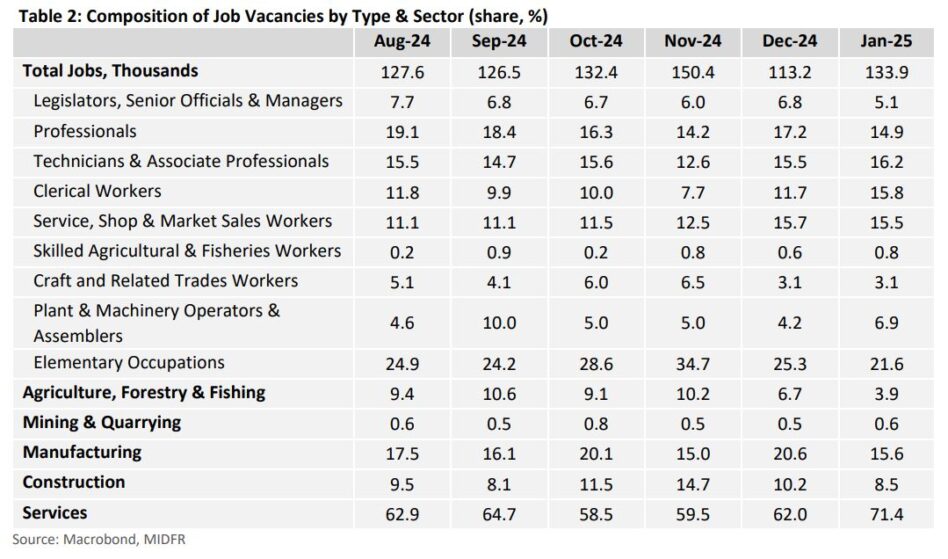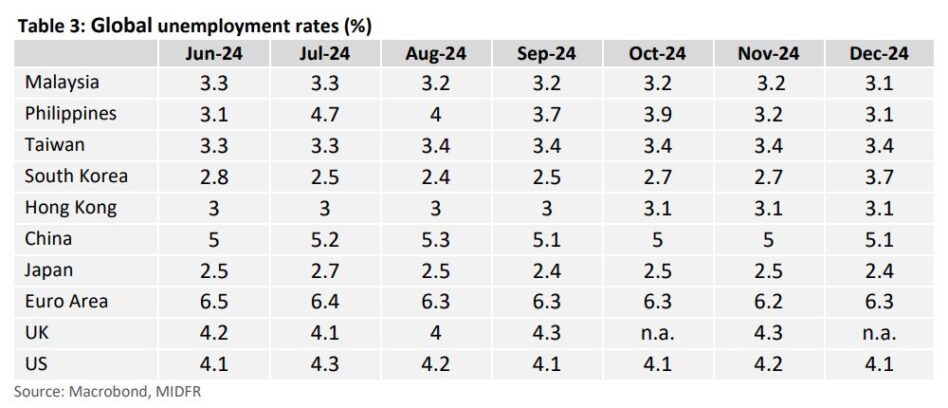MALAYSIA’s labour market marked an improvement in Dec-24, with the unemployment rate dropping to 3.1%, a near decade low and aligning with market expectations.
“This stability was underpinned by a continued rise in the labour force at +1.7% year-on-year (YoY) and steady employment growth (+1.9%yoy),” said MIDF Research (MIDF) in the recent Economic Review Report.
Notably, this marked the 41st consecutive month since Aug-21 in which employment growth outpaced the expansion of the labour force.
As a result, the number of unemployed individuals declined to 544K from 547K in Nov-24, the lowest level since Feb-20.
Unemployment count declined further by -4.1% yoy, which has consistently been on a declining trend since Sep-21.
In 2024, by employment type, employees continued to make up the largest share of total employment at 75%, followed by own-account workers (18.4%) and employers (3.6%).
All three categories contributed to employment growth, with year-on-year increases during the month of +1.4% yoy, +3.9% yoy, and +5.1%yoy, respectively.

However, the number of unpaid family workers saw a further decline of -1.5%yoy. The labour force participation rate remained high and steady at 70.6%, reflecting increased entry into the job market.
This high participation rate, combined with steady employment growth and lower unemployment rate, signals that more individuals are securing jobs amid Malaysia’s improving economic conditions.
Looking ahead, the robust labour market is expected to remain a key driver of consumer spending and domestic economic growth.
Labour demand improved in Jan-25, with job vacancies increasing to 133.9K (Dec-24: 113.2K). In terms of job categories, clerical support workers experienced the most significant month-on-month increase, with vacancies rising by +8K.
This was followed by an increase in plant and machine operators and assemblers (+4.5K), and service and sales workers (+3K).
Notably, technicians and associate professionals recorded a rebound in vacancies by +4.2K (Dec-24: -1.4K).
Sector-wise, the services sector saw a notable increase in vacancies, rising to +95.6K (Nov-24: +70.2K), primarily driven by an increase across several sub-sectors, including administrative and support service activities, transportation and storage, and human health and social work activities.
The manufacturing sector recorded a steep decline with vacancies decreasing by -2.5K to a total of 20.1K, reversing the +777 increase in vacancies in the previous month.
Similarly, the agriculture sector faced a continuous drop of -2.2K jobs, with vacancies decreasing to 5.2K (Nov-24: 7.5K).
Looking ahead, we expect Malaysia’s labour demand to remain robust in 2025 on the back of steady economic growth and the generation of new employment opportunities.
The global labour market demonstrated continued stability in Dec-24, with unemployment rates improved in most countries.

This trend highlights the resilience of the global job market. In the US, the unemployment rate slid to 4.1% (Nov-24: 4.2%) and nonfarm payrolls recorded increased by +256K (Nov-24: +212K jobs), hitting the largest job gain in nine months.
This signals a sturdy job market and stronger demand for workers, highlighting economic resilience amid still-elevated inflation.
However, China’s labour market slightly weakened, with its unemployment rate edged up to 5.1% in Dec-24. This marked the highest reading in three months.
Increase in unemployment rates was also observed in South Korea (3.7%) and Euro Area (6.3%).
Meanwhile, the Philippines reported a slight drop in its unemployment rate to 3.1% (Nov-24: 3.2%), marking the lowest level since June-23.
Other regions, such as Taiwan and Hong Kong, saw unemployment rates remain stable at 3.4% and 3.1%, respectively.
Overall, these steady unemployment figures and improved labour market data reflect the underlying stability of the global job market.

Labour demand is expected to rise further, in line with increasing global economic activity, despite challenges posed by escalating trade tensions and ongoing geopolitical conflicts.
Malaysia’s unemployment rate is projected to average lower in 2025, reflecting steady improvements in the labour market. In 2024, the average unemployment rate stood at 3.3%, slightly below 3.4% recorded in 2023.
This was accompanied by moderate growth in the labour force (+1.7%yoy; 2023: +2.0%yoy) and employment (+1.9%yoy; 2023: +2.4%yoy).
In Dec-24, the unemployment rate improved to 3.1%, and we anticipate continued growth in labour demand, supported by improving economic conditions.
With a favourable labour market outlook expected to persist, we forecast Malaysia’s average unemployment rate to improve further to 3.2% in 2025.
Despite the promising market outlook, there are emerging risks that could weigh on employment growth.
Weaker demand from major trading partners and the implementation of US protectionist trade measures poses potential challenges to Malaysia’s labour market outlook in the near term. —Feb 11, 2025
Main image: almerja.com









